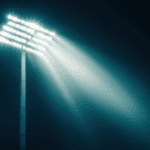When astronomers discovered asteroid 2024 YR4 on December 27, 2024, it didn’t set off any panic alarms. It won’t be crashing into Earth anytime soon, which is always nice to hear.
But that doesn’t mean it’s harmless. In fact, this seemingly well-behaved space rock may be plotting a cosmic sideswipe of another kind—aimed not at Earth, but at our closest neighbor: the Moon.
And if it does strike the Moon in 2032, it could set off a chain reaction in space that’s equal parts awe-inspiring and anxiety-inducing.
Meet Asteroid 2024 YR4: A Cosmic Wrecking Ball
Measuring between 53 and 67 meters across—about the height of a 20-story building—this asteroid is comparable in size to the one that caused the Tunguska event in 1908.
That was a mysterious explosion over Siberia that flattened around 80 million trees and left no impact crater, which still baffles scientists to this day.
Asteroid YR4 is no small fry. If it were to hit the Moon in just the right spot, the explosion would be equivalent to the blast from 6.5 metric tons of TNT.
That’s not enough to blow the Moon in half, of course, but it would gouge out a crater nearly a kilometer wide and eject a truly staggering amount of debris—about 100 million tons of lunar dust and rock—into space.
And that’s where things could get interesting… or dangerous.
Why Debris From the Moon Is a Big Deal for Earth’s Satellites
You might think that a meteor impact on the Moon is no big deal for us down here. After all, it’s 384,000 kilometers away. But modern civilization doesn’t just live on
Earth anymore—we’ve got an armada of satellites circling the planet, especially in what’s known as Low Earth Orbit (LEO).
That’s where most of our space traffic lives—around 90% of satellites, in fact. These are the satellites we rely on every day for weather reports, global positioning, international calls, internet connectivity, and even banking.
And here’s the cosmic catch: up to 10% of the Moon’s ejecta from the asteroid impact could end up getting caught in Earth’s gravitational field—some within just a few days.
That’s millions of tons of fast-flying space grit coming into satellite neighborhoods. Think of it as a surprise meteor shower, but instead of fireworks, you get tiny bullets moving at tens of thousands of kilometers per hour.
Read more: Voyager Probes Stumble Upon a Cosmic ‘Wall of Fire’ Outside Of Our Solar System
How Scientists Are Crunching the Numbers
To estimate how much of a risk this is, researchers ran simulations using data from NASA’s Center for Near-Earth Object Studies (CNEOS).
They created 10,000 digital copies of the asteroid’s orbital path—called “clones”—to account for all the unknowns and wobbles in its trajectory. Out of those, 410 simulated paths ended with the asteroid crashing into the Moon.
Not all Moon impacts are created equal. Where the asteroid lands matters—a lot. The Moon’s motion around Earth is key.
If the asteroid hits the Moon’s trailing edge, where the Moon is moving away from the asteroid, the ejected debris is more likely to get pulled toward Earth rather than just flung into deep space.
The researchers zoomed in on four likely impact locations and found that in some cases, debris could be delivered to Earth’s orbit fast—as quickly as a few days, with maximum delivery within a few months.
Meteor Mayhem: More Than Just a Pretty Light Show
Earth already has to deal with natural space debris. It’s a constant, mostly harmless drizzle of micrometeoroids—tiny particles smaller than grains of rice that burn up harmlessly in our atmosphere. Satellites are designed with this in mind.
But if asteroid 2024 YR4 hits the Moon? The floodgates open.
The ejecta from that impact could increase debris levels by up to 1,000 times the normal background flux. In short: our satellites would go from occasional pinging to being stuck in a sandblaster.
The researchers say this concentrated burst could “accelerate satellite aging” and shorten their functional lifespans.
Even more concerning: By 2032, there will be even more satellites than there are today. The boom in satellite internet constellations, like Starlink and Amazon’s Kuiper project, means a higher likelihood that space junk or natural debris will cause real problems—if not complete satellite failures, then at least expensive damages.
So, Is This a Real Threat—or Just a Cool Space Theory?
Let’s not panic just yet. The likelihood of asteroid 2024 YR4 actually hitting the Moon is only about 4%. That’s small, but it’s not zero.
There’s a silver lining: in 2028, the asteroid will swing by Earth again—harmlessly. This close approach will give astronomers another chance to observe it and fine-tune their models.
Better data means better predictions. If it turns out the odds of a Moon impact are higher than expected, agencies like NASA and ESA might start considering how to prepare spacecraft and satellite operators for a temporary spike in space debris.
And who knows? If it does hit the Moon and launches debris toward Earth, we might get one of the most beautiful meteor showers ever seen—an unexpected celestial performance with a cautionary tale stitched into every falling star.
Read more: Massive Cosmic Jets Bigger Than Our Galaxy Just Shot Out of a Black Hole
A Dusty Surprise from the Lunar Surface
Lunar dust might sound harmless—just powdery grey stuff scattered across the Moon’s surface. But for the Apollo astronauts who visited the Moon between 1969 and 1972, this “moondust” turned out to be one of the biggest unexpected challenges they faced.
When the Apollo lunar modules landed, their descent engines kicked up massive clouds of dust that blanketed the landing sites. The fine, gritty particles clung to everything: space suits, equipment, visors, and tools.
Sharp, Static, and Stubborn
Unlike Earth dust, which gets smoothed over time by weather and erosion, lunar dust is razor-sharp. Since the Moon has no wind or rain, the dust particles remain jagged and angular—like tiny shards of glass.
These particles stuck to astronauts’ gear like static and caused a host of technical problems.
Astronauts found it difficult to brush the dust off their suits. Once they re-entered the lunar module, it contaminated the interior, jammed instruments, and scratched delicate surfaces like helmet visors and control panels.
Health Hazards in the Moon Cabin
Besides technical issues, lunar dust also posed potential health risks. Some astronauts reported allergy-like symptoms after inhaling the fine particles—sneezing, watery eyes, and sore throats. Harrison Schmitt, a geologist and Apollo 17 astronaut, even said the dust smelled like burnt gunpowder.
Later studies confirmed the concern: simulated lunar dust on Earth was found to cause inflammation in lung tissue, meaning that prolonged exposure could be harmful. For future lunar missions, protecting astronauts from dust inhalation is now a top priority.
How This Connects to the 2024 YR4 Impact Scenario
The risk from asteroid 2024 YR4’s potential Moon impact is not just theoretical. If it hits, the resulting ejecta—millions of tons of lunar rock and dust—could hurl into space, with some of it speeding toward Earth’s orbital zone.
This would no longer be about dust clinging to boots. Instead, sharp, high-speed particles could bombard spacecraft, satellites, or even future lunar bases, damaging sensitive electronics and posing safety hazards for astronauts. What Apollo crews experienced on a small scale might be amplified a thousandfold.
Read more: Astronomers Detect The Most Powerful Explosions in the Universe Since the Big Bang
Lessons from the Past, Warnings for the Future
The Apollo missions taught us that lunar dust isn’t just an annoyance—it’s a technical and health challenge that must be taken seriously. With the possibility of a massive Moon impact in 2032, space agencies are now rethinking how we build for resilience—whether it’s designing better dust-proof suits or shielding satellites from debris storms.
After all, when it comes to outer space, even a little dust can become a big deal.










